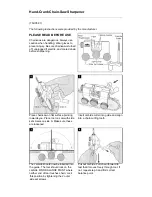
Williams & Hussey
Toll Free: 800-258-1380
15
PLANING
The planing operation removes excess wood from rough lumber to create a uniform smooth
surface. Plane rough lumber on all (4) sides until you reach the dimensional wood stock size.
The amount of stock removed in one pass is dependent on the density of the wood (relative
hardness), how wide the cut is, and the moisture content of the stock. The chart below refers to
general guidelines planing depth of cut.
GENERAL GUIDELINES FOR DEPTH OF CUT
WOOD THICKNESS
TYPE OF WOOD
PLANING DEPTH OF CUT
1”
Poplar
¼”
1”
Red Oak
3/16”
3”
White Pine
3/16”
3”
White Oak
1/8”
6”
Poplar
1/8”
6”
Red Oak
1/16”
THE SET UP
1.
Disconnect power source.
2.
Loosen all (4) 54-25 pressure screws ¼” (see caution note).
3.
Attach the planing knives.
4.
Set the head position to a height 1/32” less than the dimension of the stock.
5.
One-third of a turn on the elevating handle will equal 1/32”. Tighten the locking handle.
6.
Check knife area for clearance.
7.
Attach the chip extractor with the axis pin.
8.
Stand somewhere between the open side and in feed side to assist panel through.
9.
Power up and feed stock.
PLANING THE EDGE OF STOCK
When planing the
edge of stock
, a high, square, relieved guide is
needed in order to have the edge square and to provide stability.
To reduce friction relieve inside of both guides.
CAUTION!
When using the molder as a planer back off all (4) 54-25 pressure screws ¼”, this will
provide less roller tension. Too much tension could risk shearing the P-223 roll pin in the P-108
Rev A large bronze worm gear and will minimize snipe.
Planing Edge Example















































